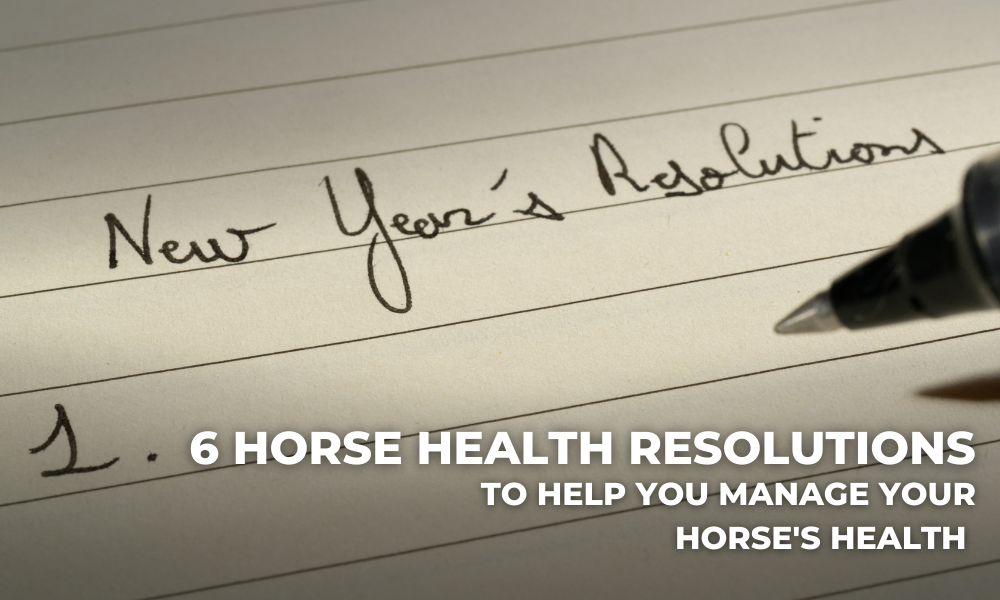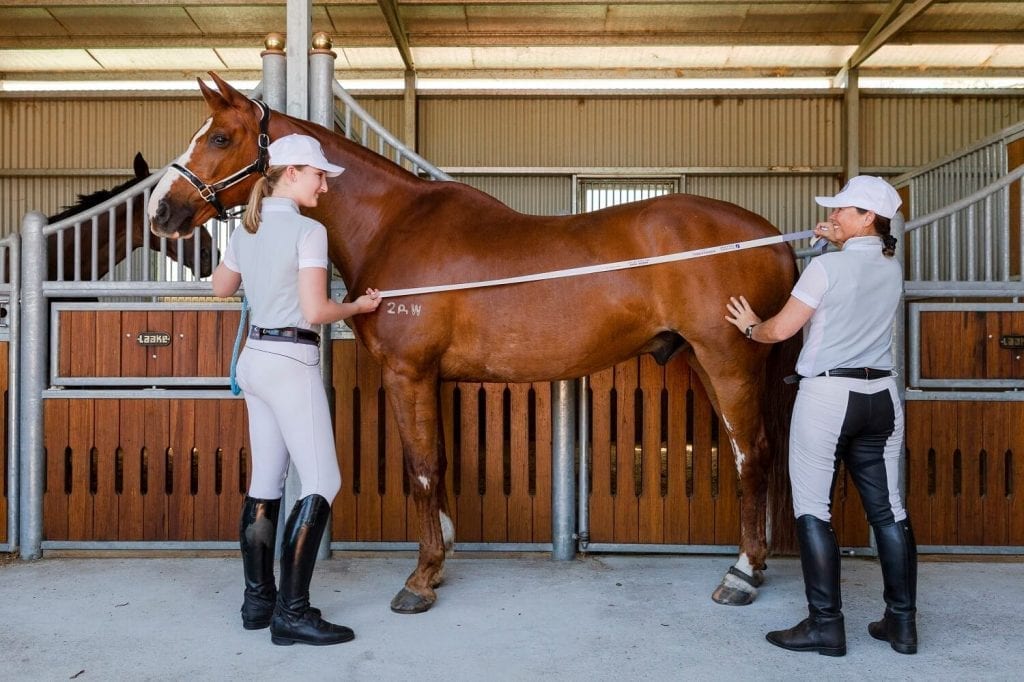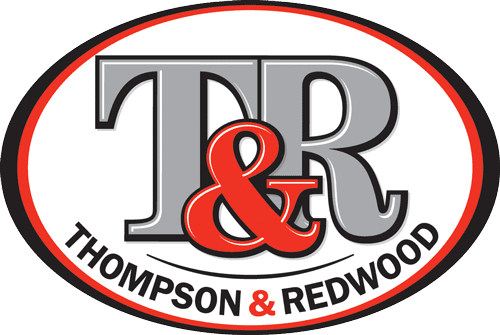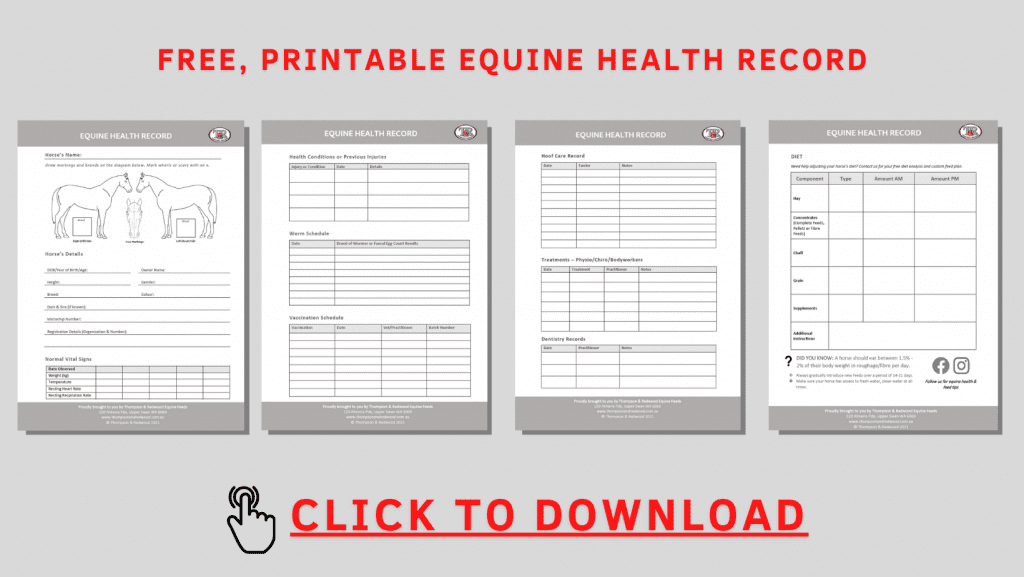
11 Jan 6 Horse Health New Year’s Resolutions!
Have you made any New Year’s resolutions for yourself this year? Health is one of the most popular topics for resolutions every year, like eating better, exercising more, getting fitter. There’s actually studies that have shown that people who set a resolution are more likely to keep it than others who just have a similar goal.
If you’re into setting resolutions, have you ever thought about setting some health resolutions for your horse? Maybe your horse actually does need to go on a diet, or get stronger, or cut down on their sugar cube consumptions! But they don’t need to be all about your horse’s diet, they can be habits and skills that you can learn too.
So we’ve put together a list of 6 horse health new year’s resolutions, that can help you become more organised and keep track of your horse’s health. Give them a go!
- Learn how to body condition score your horse, and try to do this 3-4 times per year.
- Weight out and measure each of your feed scoops so you know the exact weights of feed that they hold (and how much you’re feeding!)
- Make plans now for your horse’s diet to suit your riding goals
- Keep the labels or batch numbers from your horse feed or supplement bags
- Learn how to measure and estimate your horse’s weight
- Keep records of your horse’s diet, vital signs and health
1. Learn how to body condition score your horse
Learning how to body condition score is a great skill for horse owners to have! It can help you assess your horse or pony’s fat coverage, which is vital for determining their diet, and whether they need to lose or gain weight.
Regular body condition scoring also help you to keep track of your horse’s health, and notice any changes in condition early.
We refer to the Henneke system and Cresty Neck scoring, which helps you to determine fat coverage in vital areas that accumulate fat.
Check out our guide to condition scoring here ⬇
BODY CONDITION SCORING HORSES
CHALLENGE YOURSELF: Learn how to use the body condition scoring system, and then try and assign your horse or pony a BCS. Record it, and then reassess them 3-4 times throughout the year and see if it changes.
2. Weigh out and measure your feed scoops accurately
We’ve all been guilty of measuring our feeds by “one scoop of this, one scoop of that”. But how much feed is actually in your scoop?
Different feeds have different weights, and when we put together diets, the correct way to measure them is in weight, not volume. A set of kitchen scales are a really handy addition to your feed room. It means that you can keep an eye on the weight of what you are feeding.
So this resolution is to go and weigh out each element of your horse’s feed, and make sure you’re feeding the actually weight you should be. If you are feeding too little means your horse may not be getting their daily nutritional requirements, and feeding too much…means they may get too much!
CHALLENGE YOURSELF: This year, weigh your feeds out regularly, and if you make any adjustments (like more or less of a feed), make sure you way it, don’t just change it by feel!
3. Make plans now for your horse's diet, to match your riding goals.
Planning for the year is always exciting! What do you want to achieve with your horse? Which competitions have you put on the calendar? It’s a great idea to look at your goals and calendar, and start to plan your horse’s diet for the year.
For example, when is your first competition? Ask yourself if your horse needs to increase it’s feed or energy before this, so you can make adjustments early.
OR do you want to get to the Royal this year? It may seem a long way away, but building great topline needs to start early.
Changing feeds should always be done over 14-21 days, so being prepared is important. Planning for any changes now can help you make sure you’ve got the right feeds on hand and start making your changes when you need to.
CHALLENGE YOURSELF: What are your riding goals this year? If you haven’t already written them down (which you should…hint hint), write them down and then ask yourself if your horse will need a diet change to support those goals.
We offer a diet analysis program from our nutritionist, we’re happy to help you start planning ahead
T&R Equine Nutrition Program
4. Keep the labels or batch numbers from your feed bags
Did you know that our products have full traceability? We can trace a bag of feed all the way back to where the ingredients came from. But what does this have to do with resolutions?
Well keeping the batch numbers of your bags means if you have any problems with your feeds, or notice something different, you can contact us and let us know the batch number. You don’t have to keep ALL the labels or numbers, but if you empty your bags into a feed bin, keep the numbers until you get your next load of feed.
CHALLENGE YOURSELF: if you don’t keep the bags, you could write the key information down on a board or notebook that you keep in your feed room, along with the date you purchased them, and where you got them from.
5. Learn how to measure and estimate your horse's weight
Knowing your horse’s weight is a really important aspect of horse ownership, yet it’s amazing how many horse owners are simply taking a guess. We talk to owners about their horse’s diet daily and rarely do we hear a confident answer about our questions relating to weight.
Without having an accurate weight measurement, it’s likely that many horse owners are not providing a balanced feeding program. Likewise, it’s just as vital to know your horse’s weight when worming or administering medication.
A recent study by Auburn University researchers showed the most accurate DIY way to measure your own horse’s weight is to use the estimation formula: (kg)=(heart girth2 x body length) / (11,880 cm3) with length defined as “measuring from the point of shoulder to the point of buttock”.
All you need is a measuring tape, piece of string or even baling twine (and maybe a friend to help you get the most accurate result.)
Read our full instructions for measuring to estimate your horse’s weight here ⬇
FORMULA FOR MEASURING YOUR HORSE’S WEIGHT
CHALLENGE YOURSELF: Try and guess your horse’s weight, than have a go at measuring your horse or pony and calculating their weight. Did you get it right? Right it down, and then do them again at the end of the year. How much did they change?

6. Try to Keep records of your horse's health throughout the year.
Are you disciplined at record keeping? If not, maybe this is the year to start!
It’s a really good idea to keep regular records of your horse’s health, vital signs, vaccinations, treatments and diet. We always think we’ll remember which date they had their last needle or the dentist, but we often forget.
You can use our FREE EQUINE HEALTH RECORD which is easy to download and print, and keep in your grooming box or first aid kit. It’s even got space to record your horse’s weight (if you do resolution number 5!)
DOWNLOAD OUR FREE PRINTABLE HEALTH RECORD
CHALLENGE YOURSELF: On page 1, record your horse’s normal vital signs. Use the formula in Resolution 5 to estimate your horse’s weight, take their temperature, resting heart rate and resting respiration rate. Knowing their normal vital signs means you if you are worried about them, you can compare it to their ‘base line’.
Have a great year everyone, we hope you’ve taken some inspiration from our 6 horse health new year’s resolutions, and they can help you achieve your own horse health goals in 2022.





No Comments